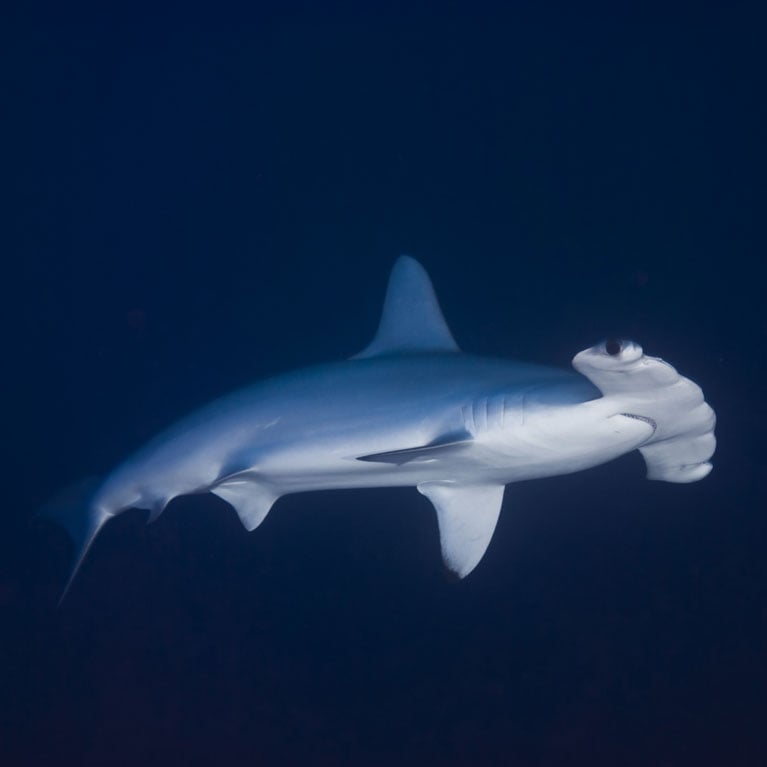Gut feeling: the impact of heavy metals on shark microbiomes
A healthy microbiome is key to fitness in sharks and rays, but increasing amounts of heavy metals in the ocean could disrupt these microbes and impact shark and ray immune systems. Miguel wants to understand shark microbiomes because impaired immunity will make already threatened sharks and rays more susceptible to environmental stress. His project will sample gut microbes from smooth hammerheads and giant electric rays in the Gulf of California, Mexico. By describing the microbiome in these sharks and rays from both polluted and unpolluted sites, Miguel hopes to understand if heavy metals lower microbial diversity.
I was born in La Paz in southern Baja California, Mexico, where we are privileged to be surrounded by pristine beaches and incredibly rich marine fauna. As my father was a marine biologist, when my brother and I were young we spent a lot of time at sea, where he taught us to appreciate and protect all marine animals. Naturally, this led me to study marine biology too. But while I really loved field trips and ecological studies, at some point I realised that I was more interested in understanding marine life at a deeper level. So I shifted from...


Elasmobranch gut microbiome and heavy metal: Description of the microbiome in a highly polluted habitat
To describe the gastro-intestinal microbiome of sharks and rays from a site with high levels of heavy metals and from two other unpolluted sites. With this information we will attempt to determine whether heavy metals induce lower diversity in the microbial composition and to identify potential biomarker communities.
The gastro-intestinal microbiome in animals is a crucial factor in their health and their response to the environment. Heavy metals can disrupt microbial communities with deleterious effects on the host’s metabolic capacity or immune system, resulting in the host being more susceptible to disease or environmental fluctuations. This project will provide baseline information about the microbiome diversity in a pelagic shark and a demersal ray and will identify changes in the composition of their microbiomes due to heavy metal pollution.
The microbial community present in the gastro-intestinal tract of animals plays a pivotal role in food digestion and nutrient uptake. The composition of the gastro-intestinal microbiome of terrestrial and marine animals can be affected by the presence of heavy metals; either the diversity of bacteria may be reduced or the abundance of metal-resistance bacteria may be increased. Such structural shifts in the microbial composition can be used as bio-indicators when monitoring the health status of elasmobranchs. However, there are still no comprehensive studies that describe the core microbial composition of sharks and rays. It is therefore important to first characterise the microbiome composition of the gut in species with different lifestyles and diets and then determine whether heavy metal pollution induces a shift from the ‘normal’ composition to a low-diversity microbiome community.
The Gulf of California in Mexico has a rich diversity of elasmobranch species, resulting in an important small-scale fishery that targets sharks and rays. Moreover, the coastal region around Santa Rosalia, inside the Gulf of California, is known to have high levels of heavy metals due to historical copper-mining activities. In particular, high levels of copper, zinc, cobalt, manganese, lead and uranium have been identified in sediments and have led to an important accumulation of these metals in several invertebrates. As top predators, sharks and rays are particularly vulnerable to the bio-accumulation of heavy metals, since the most important route of heavy metal uptake is through food. Previous studies have already detected the presence of heavy metals in the tissue of sharks and rays from the Santa Rosalia basin. In this project we aim to find out whether microbial diversity is lower in sharks and rays from a site with high levels of heavy metals in relation to sharks and rays from unpolluted sites.
- To collect digestive tract samples from smooth hammerhead sharks Sphyrna zygaena and giant electric rays Narcine entemedor from three sites within the Gulf of California: one with high levels of heavy metal pollution and two with less human influence.
- To characterise the microbiome composition of the digestive tract from each species in all localities by sequencing the hypervariable region of the 16S rRNA gene.
- To identify a species-specific and/or site-specific bacterial community composition as well as to identify taxonomic groups associated with distinct functional signatures relating to heavy metal pollution at the Santa Rosalia site.
Summary of main research results/outcomes
Elasmobranchs host beneficial microorganisms in their stomach that support digestion, health, and immunity. This study aimed to establish a baseline of gut microbiota composition in four elasmobranch species from the Gulf of California, Mexico. The species included pelagic (sharpnose shark, hammerhead) and demersal (angel shark, electric ray) species from two sites in the Gulf of California. Metabarcoding of the 16S rDNA gene identified dominant bacteria in all species, such as Vibriomonas, Ralstonia, and Photobacterium, which are crucial for digesting complex macromolecules like chitin.
However, this study found no general difference in microbial diversity between locations, except for a higher relative abundance of Photobacterium damselae in the sharpnose shark from the site with a high presence of heavy metals. This bacterial species is a common pathogen in fishes, but it has been found to be part of the gut microbiota of elasmobranchs. Its functional and ecological role warrants further investigation.

